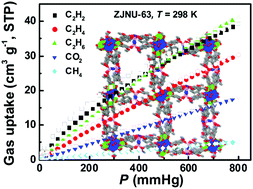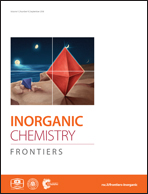Structural diversities and gas adsorption properties of a family of rod-packing lanthanide–organic frameworks based on cyclotriphosphazene-functionalized hexacarboxylate derivatives†
Abstract
Solvothermal reactions of cyclotriphosphazene-functionalized hexacarboxylate derivatives bearing different substituents (methoxy, chloro, bromo and methyl) with Ho(NO3)3·6H2O gave rise to four new three-dimensional lanthanide metal–organic frameworks (Ln-MOFs). Single-crystal X-ray diffraction analyses reveal that they all feature rod-shaped Ho-carboxylate chains as inorganic secondary building units but display substituent-driven structural diversities instead of the isoreticular structures. N2 adsorption and desorption studies show that among these Ln-MOFs, only the methoxy-modified Ln-MOF ZJNU-63 after activation exhibits permanent porosity. Furthermore, the gas adsorption properties of ZJNU-63 with respect to C2H2, C2H4, C2H6, CO2, and CH4 were systematically investigated, revealing its possible potential for natural gas purification. Although the separation performance is not very impressive compared to the other reported MOFs, ZJNU-63 presents a rare example of permanently porous Ln-MOFs constructed from flexible organic ligands displaying selective gas adsorption. Besides, ZJNU-63 can adsorb a large amount of C4 hydrocarbons with uptake capacities ranging from 58.8 to 75.7 cm3 (STP) g−1 at 298 K and 1 atm.



 Please wait while we load your content...
Please wait while we load your content...